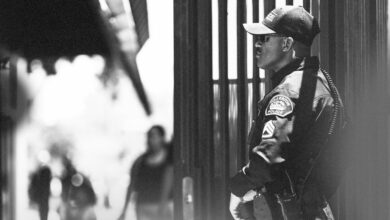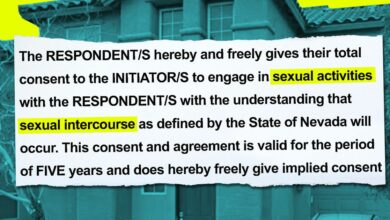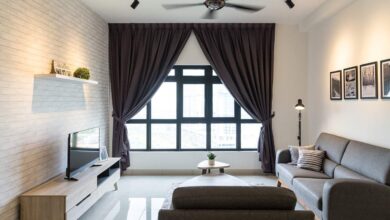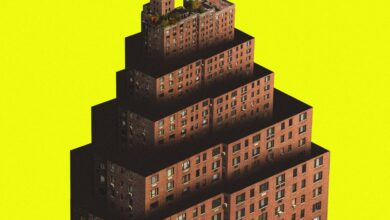MoMA’s ‘Reconstructions’ Changed My Relationship to Space
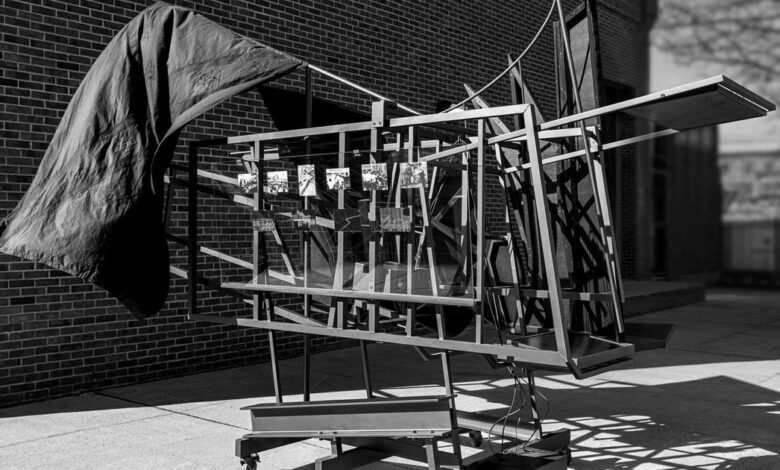

Mario Gooden’s “The Refusal of Space” (2020) on view at “Reconstructions.”
Photo: Kris Graves. Image courtesy of the artist. The Museum of Modern Art, New York
What do exhibitions about Black life accomplish? Do they revise an art history that excluded us? Or do they invite us on a fool’s quest for the illusion of equity? And when are Black voices listened to most closely — in an exhibition audio guide or in an open letter shared on Twitter? The Museum of Modern Art’s “Reconstructions: Architecture and Blackness in America,” organized by Sean Anderson and Mabel O. Wilson, with Arièle Dionne-Krosnick and Anna Burckhardt, flirts with the foundations of these questions.
Looking at the context of this show, it’s easy to get distracted by the elephant in the room: the architect and Nazi-enthusiast Philip Johnson. After all, the public story of this exhibition began months before its launch, with the Johnson Study Group’s open letter demanding that Philip Johnson’s name be removed from all spaces and titles at the Museum of Modern Art, as well as at the Harvard Graduate School of Design and “any other public-facing nonprofit in the United States bearing the name of Philip Johnson.” As a writer, and more important, as a Black writer, I refuse to be enchanted by this siren song. It would be unfair to harp on the failures (read as: successes) of whiteness embodied in Johnson’s vaulted position at the MoMA when this show is mounted with an explicit and implicit dedication to Blackness and its myriad modes of being.
Still, it is imperative to dig deeper into the “where” and “why” of this show before we dig into the “what” of it. As artist Amanda Williams inscribed in her installation, We’re Not Down There, We’re Over Here, “Black space will not be amongst great architectural design canons.” If not in the canon, then where can the room for Black space be made? As the Johnson Study Group letter, published in November 2020, states, “Naming titles and spaces inevitably suggests that the honoree is a model for curators, administrators, students, and others who participate in these institutions.” And what kind of model was Johnson? According to the largely anonymous group of designers and architects who drafted the letter, “Johnson’s commitment to white supremacy was consistent and consequential,” and during his nearly six-decade-long tenure as the founder, and later the head, of MoMA’s Department of Architecture, “not a single work by any Black architect or designer was included in the collection.” That tells us all we need to know about the task set before the organizers of “Reconstructions.” Do they revise this history? Or do they revolt? And how do they avoid being complicit in it?
The show opens with a large text statement and three QR codes printed on a burlap-colored banner, which covers MoMA’s signature silver signage bearing Philip Johnson’s name. This piece is by The Black Reconstruction Collective, a newly formed 501(c)(3) nonprofit organization founded by the participating artists during the early planning stage of the exhibition to “provide funding, design, and intellectual support to the ongoing and incomplete project of emancipation for the African Diaspora.” Concretely, it aims to take an active role in designing a future where there is more equity — including resources and exhibition opportunities —for Black thinkers and designers. The banner shares the Black Reconstruction Collective’s “manifesting statement,” which recasts architecture in terms of what it can be — “a vehicle for liberation and joy” — countering what it has often been, a tool of repression and racism, and offers this collective promise: “We commit ourselves to annihilating the willful blinders that have enabled architecture to continue to profess its Eurocentrism as a virtue and claim apolitical ends.” This banner, with its three QR codes, is a brilliant act of redirection — any photo of it prompts the user to visit the website for the Collective. The names of its members may only temporarily take the place of Philip Johnson’s, but they conceal his name rather than share space with it. The first work of the exhibition is thus a reckoning of sorts, a public grappling with the persistence of white supremacy in the discipline.
The show’s concept and genealogy can be traced, of course, to the original Reconstruction Era, which spanned from 1865 to 1877, following the end of the Civil War. It was a time of racial and economic retribution in American history, as the country slowly loosened itself from the grip of slavery and the transatlantic slave trade. During Reconstruction, newly emancipated Black Americans fought for suffrage and pushed back against racist Black Codes that were instituted to suppress their movement and their rights. The BRC, inspired by this period of radical reinvention, carries this ongoing project into the present day. Much like its eponymous inspiration, the exhibition endeavors to imagine worlds beyond the fascist erasure of Black talent. It asks whether Black people were really emancipated during Reconstruction if we could not own land, vote, or exist without persecution in public space. The assembly of the BRC itself represents their desire to not only join dialogues about architecture and city planning but directly participate in the construction and reconstruction of this nation.
J. Yolande Daniels. A dictionary plate that is part of “Black City: Los Angeles Edition,” (2020) on view at Reconstructions.
Art: Image courtesy of the artist. The Museum of Modern Art, New York
Entering the exhibition, you encounter an atlas assembled by the Los Angeles–based artist J. Yolande Daniels. In Black City: The Los Angeles Edition, Daniels explores the history of Black settlement in Los Angeles, from its founding by the Spanish in 1781 through its American occupation. The work — a mixture of traditional architectural schematics and a somewhat illegible foam model — offers an ode to the legacy of Biddy Mason, an enslaved woman who filed a writ of habeas corpus to petition for her freedom and that of her three children, Ellen, Ann, and Harriet. Mason, who is now rightfully acclaimed as an American hero, filed her petition when her enslaver, Robert Marion Smith, followed the call from the Mormon church to move his enslaved persons to California, a state where slavery had been outlawed. After being granted her petition in 1856, Mason moved to Los Angeles with her family and continued working as a midwife and nurse, saving her earnings and using the money to purchase land in what is now the heart of downtown L.A. According to the National Parks archive, “Mason used her wealth, estimated to be about $3 million, to become a philanthropist to the entire L.A. community.”
The resulting work by Daniels is composed of maps that literally and figuratively layer the city’s rich history of Black urban life on top of a contemporary map of the city. In the accompanying audio guide, Daniels says, “African Americans are often made to feel that we have no history or that our history is only sorrow, but the people who were making the history, they were fighting all the time to realize good things for themselves and for their family, and for others.” Biddy Mason successfully used habeas corpus to claim her right to move freely in space, but Daniels’s map reminds us how precarious these wins for the Black community could be. In 2021, we see a similar fight continue around the state’s planned return of Bruce’s Beach, a part of the coastline in Los Angeles’s Manhattan Beach that was once a resort for the Black community and seized by the state during the Jim Crow era. Daniels’s map resurfaces some of the buried truth of this land.
To talk about this exhibition is also to consider its layout and how bodies move through it. During my last visit to MoMA, I had the pleasure of visiting Park McArthur’s brilliant “Projects 195,” in which the ambitious audio guide designed by the artist not only maximizes accessibility for all visitors but is also the artwork itself, as she examines MoMA’s expansion and offers a counterproposal of a building for disabled and non-disabled people to live in a shared community together. Much like McArthur’s guide, the “Reconstructions” guide also includes audio and in-depth textual descriptions of the works on view, but McArthur’s influence resonated with me deeply as I wandered through the show, and I found myself becoming increasingly curious about the placement of objects on the walls and within the space.
If you access the “Reconstructions” exhibition via the north elevator, you’re greeted by a large map of the United States, which uses the color green to indicate “All-Black” towns, “Freedmen’s” towns, and “Freedom Colonies,” all of which were founded as “‘defensive communities” intended to protect their Black residents against the ravages of racist Jim Crow laws. On this map, which is admittedly incomplete, we also see black dots indicating the locations considered by the artists in the exhibition. For a show in which spatial relations are both deeply personal and political, it is bewildering to move from one work of art to another while also traveling from Miami to Syracuse to Atlanta and back again. This show talks about space, but it says very little about migration — especially the movement of Black people from the South to cities in the north, Midwest, and West. When visitors hop from New Orleans to Oakland, are they not also following the course of the Second Great Migration? Are they not also made dizzy, if not weary, by this unacknowledged journey? Does the emotional toll of this voyage matter?
This said, as I stared at the map, I had to pause. For a moment, I released the tension in my jaw — mostly the result of the two surgical masks I had donned to travel safely to and from the museum — and took out my phone. I began to text my father and his eldest sister about our family roots in Boonville, Missouri. I asked, “Do we have any connection to Kinloch?” I had started to think so much about them as I stood below Amanda Williams’s tributary piece to Kinloch, Missouri’s first Free Town. In the audio guide, Williams says, “Often, Black people in America are not given the space at all to even just be. A lot of time is spent just concerning ourselves with staying alive.” This resonated with me, knowing I had risked my life even to visit the show in the weeks before I got vaccinated, and knowing the pandemic’s severe and disproportionate impact on Black communities. But it was also true that in that moment, in a museum gallery far from the comforts of home and during a time where longing is a way of life, I was deeply immersed in a conversation with my family about our relationship to space and notions of home and community.
Sekou Cooke, We Outchea: Hip Hop Fabrications and Public Space.(2020) on view at Reconstructions.
Photo: Robert Gerhardt, The Museum of Modern Art
Later, I took a quick trip to Sekou Cooke’s speculative vision for Syracuse, New York, which includes a full-scale slice of a stoop made of precast concrete and plywood. The piece, part of Cooke’s We Outchea: Hip Hop Fabrications and Public Space, nods to the stoop as a place of connection and a staple within the architecture of city blocks. Seeing it was a welcome reminder of my own childhood and sweet summers spent with family. As I examined Cooke’s work, which looks at the demolition of Black neighborhoods in the old 15th Ward by Syracuse city planners, I peeled out my phone again, this time to chat with my cousin David, who works alongside city planners across the United States. He told me about his co-worker Lydia Gaby, a city planner whose family hails from Tulsa, Oklahoma, and later migrated to Springfield, Massachusetts. He shared her number, and Gaby and I began a discussion about city planning in the present day. For her, one of the more difficult aspects of city planning and speculative design is the challenge of not repeating the same mistakes of the past when building new spaces. For example, if the Syracuse Housing Foundation’s current “Blueprint 15” project, which replaces the low-income housing in Syracuse’s historic 15th Ward with mixed-income housing, doesn’t pan out, how do we know that city officials won’t level the Ward just as they did in 1959? This is the potential future that Cooke’s work invokes.
“Reconstructions: Architecture and Blackness in America” is undoubtedly a feat that will be celebrated for years to come. The evolution of the scholarship and archival practices on Black space, the opportunity for healing for those impacted by both the violence of city planning and by fascist curation, and an all-around enriching viewing experience made the visit well worth it. You can feel the labor of love in every corner of its maybe-too-small holding space within the womb of the MoMA. It is a show that left me hungering for so much more — hungering for a better spatial awareness of America, this land which my people did not choose to inhabit, and hungering for a deeper connection with each artist in the exhibition. This show markedly changed me. Commuting home to Bushwick, I thought about every piece of city infrastructure I interacted with, from the subway railings I held to the electric lines crossing above my head. I had been awakened to the fact that we should never take infrastructure for granted.
And yet the final query remains: What do exhibitions about Black life accomplish? And, moreover, who are they for? While I do not have a singular answer to these questions, I did find some solace in a detail from Walter Hood’s image of Oakland in his work Black Towers/Black Power. Tucked above a series of models and drawings of a speculative Oakland, he inserts calls from the Black Panther Party’s Ten-Point Program. In one section, the words, “WE WANT EDUCATION THAT TEACHES US OUR TRUE HISTORY AND OUR ROLE IN THE PRESENT-DAY SOCIETY” preside over the space. It is my sincere hope that the education introduced by this exhibition only continues.
Walter Hood, Black Towers/Black Power (2020) on view at Reconstructions.
Photo: © 2021 The Museum of Modern Art. Photo: Robert Gerhardt




